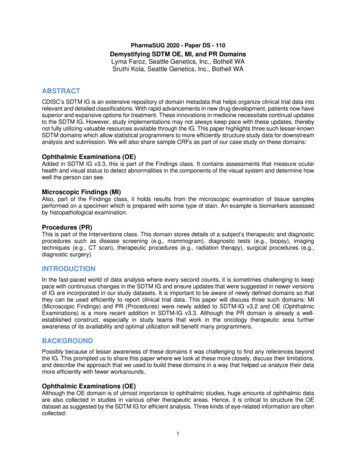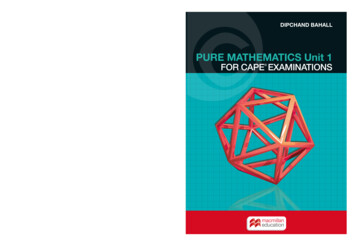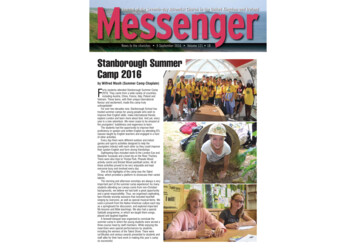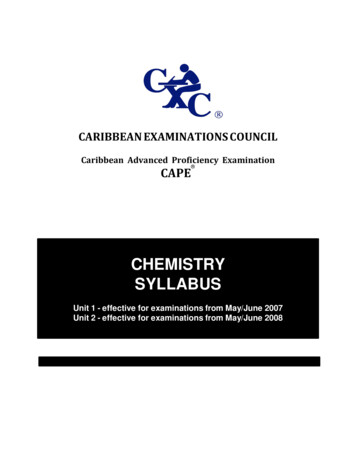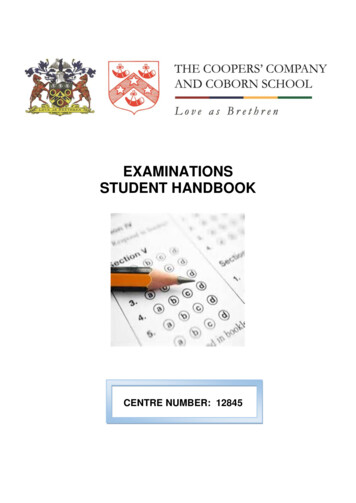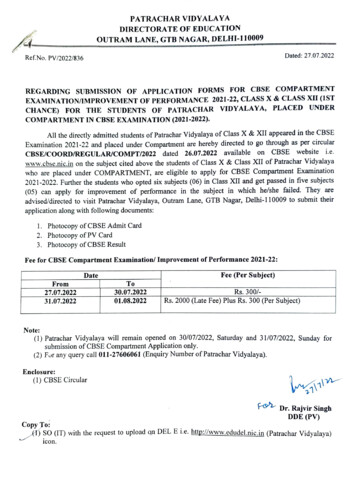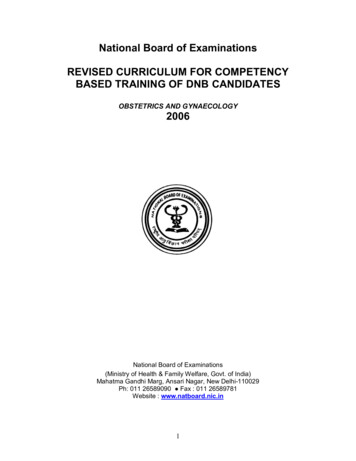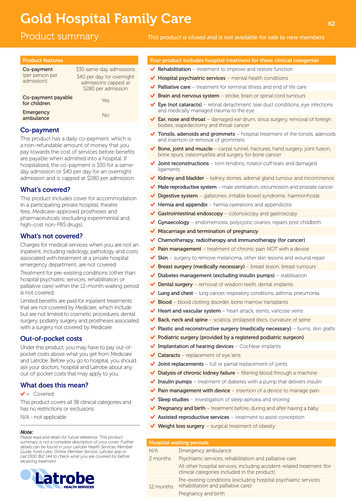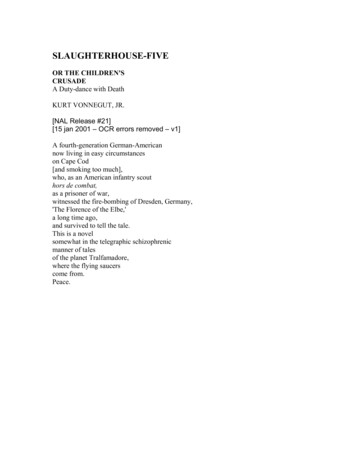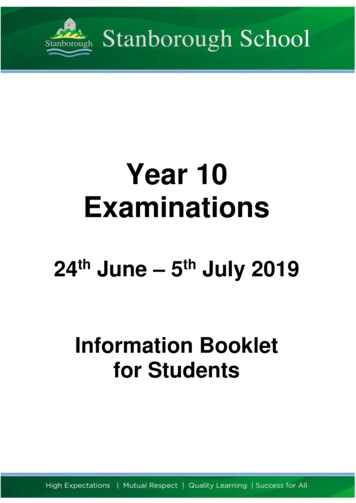
Transcription
Year 10Examinations24th June – 5th July 2019Information Bookletfor StudentsDear Student
Dear Student,You are now less than a year away from sitting your actual GCSE exams,therefore the exams you will sit this summer are designed to give you,your teachers and your parents an idea of how you are progressing inyour chosen subjects.They are also designed to give you a better idea of what type of revisionstrategies work best for you and help you learn about how you as alearner can prepare effectively for exams.The main message is simple. Preparation is everything! If you preparewell for an exam you are far more likely to be successful and achieve agood result.Please use this guide to help you prepare for these important exams.We hope you find this booklet useful. If you have any questions pleasesee your subject teachers, tutor or year leader.Wishing you the best of luck!Mrs M RidgeonYear Leader: Year 10Mrs J VlijterAssistant Headteacher
SECTION AYear 10 Exam InformationBy Subject
ENGLISH.Length of Exam: Language Paper 2 hoursLiterature Paper 2 hoursTopics Included in the Exam:Language Paper 1-- Communicating Information and Ideas (2 hours) Reading and writing paperReading comprehension and writing creativelyLiterature Paper 2-- Jekyll and Hyde and Inspector Calls (2 hours) Good knowledge of the plot structureQuotations memorised from a range of moments and charactersGood knowledge of PETER/PEEL/PETAL paragraphsComparison essay structure needed for An Inspector Calls paperHow Students Can Prepare Well For This Exam Faculty website - stanboroughenglish.wixsite.com/englisho Access past paperso Help with quotationso Listen to the audio book of Jekyll and Hydeo Quick links to Youtube revision videoso Access past lesson planso Revision objectivesShmoop.comSparknotes.comBBCbitesize.com
MATHS.Length of Exam: 60 minutes for each paper (non-calculator and calculator paper)Topics Included in the Exam:FOUNDATIONNumber: Place Value, Factors and Multiples, Powers, Rounding, Problems on LCMand HCF, Negative numbers, Fractions, Decimals, Percentages (including working out% change and Compound Interest problems), Ratio and Proportion (Best valueproblems, Recipe type problems), Finding the reciprocalAlgebra: Collecting Like Terms, Simplify by multiplying terms, Laws of Indices,Forming algebraic expressions, Substitution, Expanding Brackets, Solving Equationsand Inequalities, Straight Line Graphs, Simple FactorisationShape: Basic angle facts, Angles on Parallel Lines, Angles in Polygons, Area andVolume, Scale Diagrams and Bearings, Rotations and Reflections, Constructions andLociData: Two way tables, Scatter Graphs, Frequency Polygons, Averages (includingaverages from a frequency table), Pie Charts, Simple Probability, Frequency Trees,Venn Diagrams, Probability Tree DiagramsHIGHERAll of the above plus Number: m recurring decimal into a fraction, Standard FormAlgebra: nth term, Rearranging formulae, Quadratic Factorisation, Quadratic Graphs,Simultaneous Equations, Equations with fractionsShape: Pythagoras’ Theorem, Trigonometry, Circle Theorems,Data: Cumulative Frequency, Box Plots, HistogramsHow Students Can Prepare Well For This Exam- Website: www.mymaths.co.uk- Edexcel Exam Board Resource: Pearson Edexcel Revision Guide/Revision Workbook(these can be purchased from school, payment can be made via WisePay)- In school support: After school Maths Club (Tuesdays in G10)- Students can also revise using their exercise books and by making revision cards. Inorder to solve some of the problems, students will have to apply rules and formulaee.g. areas of various shapes. These must be memorised. They won’t be given to you.- Students must remember to bring all equipment, including a scientific calculator.LRC sells all of these at a very competitive rate.- When writing the exam, students must show workings for questions which areworth more than 1 mark. Include units with answers where appropriate. Diagramsand graphs must be drawn using a pencil and where appropriate, use a ruler. Whensolving problems involving lots of words, use a highlighter to highlight keyinformation. Be aware about the fact that some questions will ask to round theanswer to a certain degree of accuracy. Always round money to 2 decimal places.
SCIENCE – BIOLOGY (Paper 1).Length of Exam: 1hour 15 minutesTopics Included in the Exam: Cell structure & Transport – Animal/plant/specialised Cells, Diffusion/osmosis/activeTransport.Cell Division – mitosis/stem cells.Organisation & Digestive System – tissues and organs in digestive system, enzymes andfactors affecting enzymes, how the digestive system works.Organising animals & Plants – components of blood, blood vessels, the heart, respiratorysystem, tissues and organs in plants, transport system in plants (xylem & phloem),evaporation and transpiration.Communicable Diseases – pathogens and disease, growing bacteria, prevention ofinfections, viral diseases, bacterial diseases.Preventing & Treating Disease – Vaccinations, antibiotics, developing drugs (monoclonalantibodies & uses – Triple Only).Non-Communicable Disease – Risk factors for disease, cancer & tumour formation,smoking and other carcinogens, alcohol, diet, exercise and disease, type 2 diabetes.Photosynthesis – Leaf adaptations, factors affecting rate of photosynthesis, how plantsuse glucose.Respiration – Aerobic, Anaerobic, the liver, (Role of the liver – triple only).Required Practical’s – You need to know the method and results for each practical1. Using a light microscope.2. The effect of antiseptics or antibiotics on bacterial growth.3. Investigate the rate of Osmosis in different concentrations of salt/sugar.4. Food Tests.5. Effect of pH on rate of amylase enzyme.6. Effect of light intensity on rate of photosynthesis.How Students Can Prepare Well For This Exam Ensure you know the required practicals, their methods and what the results showyou (eg. What colour does Benedict’s solution turn if glucose is present?).Use the attached checklist to inform your revision.Ensure you have purchased and use the revision guides. The combined science bookis 4 and the separate science book is 12. Please pay for these on wisepay andthen collect your book from your science teacher.Create mind maps or revision cue cards.Use different colours in your notes.Use Kerboodle – make sure you know your login and password.Use the Revision Placemats available from the science prep room.Use BBC Bitesize - h You Tube (Primrose Kitten)https://www.youtube.com/watch?v mKYQ-K23Mr4 (biology Paper 1 AQA - content)https://www.youtube.com/watch?v uUrOWND2W8s (biology Paper 1 AQA –revision questions)
Paper 1 GCSE Biology SEPARATE SCIENCE Student ChecklistYour Biology mock will cover the topics outlined below. Ensure you use the online textbookfor Biology to review each topic, produce revision materials and test imal and Plant Cells6-7Eukaryotic and Prokaryotic Cells8-9Specialisation in Plant and Animal Cells10-13Diffusion14-15Osmosis16-19Active Transport20-21Exchanging Materials22-23Cell division26-27Growth and Differentiation28-29Stem Cells30-33Tissues and Organs36-37Human Digestive System38-39 and 46-47Chemistry of Food40-41Catalysts and Enzymes42-43 and 48-49Factors affecting Enzyme Action44-45Blood52-53Blood Vessels54-55The Heart56-57Helping the Heart58-59Breathing and Gas Exchange60-61Tissues and Organs in Plants62-63Transport in Plants64-67Factors affecting Transpiration68-69Health and Disease74-75Pathogens and Disease76-77Growing Bacteria in the Lab78-79Preventing Bacterial Growth80-81Preventing Infection82-83Viral Diseases84-85Bacterial Diseases86-87Diseases caused by Fungi and Protists88-89Human Defence Responses90-91Plant Diseases92-93Plant Defence Response94-95Vaccination98-99Antibiotics and Painkillers100-101Discovering and Developing Drugs102-105Making Monoclonal Antibodies106-107Uses of Monoclonal Antibodies108-109Photosynthesis124-125Rate of Photosynthesis126-127How Plants use Glucose128-129Making the Most of Photosynthesis130-131Aerobic Respiration134-135Response to Exercise136-137Anaerobic Respiration138-139Metabolism and the Liver140-141
Paper 1 GCSE Biology TRILOGY SCIENCE Student ChecklistYour mock will cover the topics of Biology outlined below. Ensure you use the online textbookfor Biology to review each topic, produce revision materials and test imal and Plant Cells6-7Eukaryotic and Prokaryotic Cells8-9Specialisation in Plant and Animal Cells10-13Diffusion14-15Osmosis16-19Active Transport20-21Exchanging Materials22-23Cell division26-27Growth and Differentiation28-29Stem Cells30-33Tissues and Organs36-37Human Digestive System38-39 and 46-47Chemistry of Food40-41Catalysts and Enzymes42-43 and 48-49Factors affecting Enzyme Action44-45Blood52-53Blood Vessels54-55The Heart56-57Helping the Heart58-59Breathing and Gas Exchange60-61Tissues and Organs in Plants62-63Transport in Plants64-67Factors affecting Transpiration68-69Health and Disease74-75Pathogens and Disease76-77Preventing Infection82-83Viral Diseases84-85Bacterial Diseases86-87Diseases caused by Fungi and Protists88-89Human Defence Responses90-91Vaccination98-99Antibiotics and Painkillers100-101Discovering and Developing Drugs102-105Photosynthesis124-125Rate of Photosynthesis126-127How Plants use Glucose128-129Making the Most of Photosynthesis130-131Aerobic Respiration134-135Response to Exercise136-137Anaerobic Respiration138-139Metabolism and the Liver140-141
ART.Length of Exam: 5 HoursTopics Included in the Exam:Students will be expected to create a ‘mini outcome’ that will accompany theircoursework as they lead up towards their final outcome later in the year. This piecemay be a singular study or a series that shows a clear link to their current workingpractise, development and artist research.Students are advised to think ‘outside of the box’ and play to their strengths in termsof media. A purposeful and meaningful response will be required which should showevidence that students are able to communicate ideas clearly in a refined and skilfulway.How Students Can Prepare Well For This ExamStudents are advised to plan each hour of their 5 hour exam and utilise timeefficiently to keep on top of pace and progress. Backgrounds and outlines may beprepped prior to the day.In the morning of the exam, students must come equipped with images to supportthe ‘mini outcome’ and their coursework boards to make reference too, they willalso be advised to create a mini mock ahead of the day to trial whether the outcomewill be successful.
BUSINESS (GCSE).Length of Exam: 1 hour 30 minutesTopics Included in the Exam: Topic 1.1 – Enterprise and entrepreneurshipTopic 1.2 – Spotting a business opportunityTopic 1.3 – Putting a business idea into practiceTopic 1.4 – Making the business effectiveTopic 1.5 – Understanding external influencesHow Students Can Prepare Well For This Exam Please use your business folder for revisionRevise from the endorsed GCSE book ‘Edexcel GCSE (9-1) Business’Business Bitesize website: 2u website: https://www.tutor2u.net/business type key business word intothe search facility.
COMPUTER SCIENCE (GCSE).Length of Exam: 1 hour 30 minutesTopics Included in the Exam:1.1 Systems architecture the purpose of the CPU and Von Neumann architecture MAR (Memory Address Register), MDR (Memory Data Register), ProgramCounter, Accumulator common CPU components and their function: Arithmetic Logic Unit, Control Unit,Cache the function of the CPU as fetch and execute instructions stored in memory how common characteristics of CPUs affect their performance embedded systems1.2 Memory the difference between RAM and ROM the purpose of ROM and RAM in a computer system the need for virtual memory1.3 Storage the need for secondary storage data capacity and calculation of data capacity requirements common types of storage: optical, magnetic, solid state suitable storage devices and storage media for a given application, and theadvantages and disadvantages of these storage characteristics1.4 Wired and wireless networks types of networks: LAN (Local Area Network) WAN (Wide Area Network) factors that affect the performance of networks the different roles of computers in a client-server and a peer-to-peer network the hardware needed to connect stand-alone computers into a Local AreaNetwork: the internet concept of virtual networks.1.5 Network topologies, protocols and layers star and mesh network topologies Wifi: frequency and channels, encryption ethernet the uses of IP addressing, MAC addressing, and protocols. the concept of layers packet switching.1.6 System security forms of attack and threats posed to networks: malware, phishing, people as the‘weak point’ in secure systems (social engineering), brute force attacks, denial ofservice attacks, data interception and theft, the concept of SQL injection
identifying and preventing vulnerabilities: penetration testing, network forensics,network policies, anti-malware software, firewalls, user access levels, passwords,encryption.1.7 Systems Software the purpose and functionality of systems software operating systems: user interface, memory management/multitasking, peripheralmanagement and drivers, user management, file management utility system software: encryption software, defragmentation, data compression2.1 Algorithms computational thinking: abstraction, decomposition, algorithmic thinking standard searching algorithms: binary search, linear search standard sorting algorithms: bubble sort, merge sort, insertion sort algorithms using: pseudocode, using flow diagrams2.2 Programming techniques the use of variables, constants, operators, inputs, outputs and assignments basic programming constructs, sequence, selection, iteration (count andcondition controlled loops) the use of basic string manipulation and basic file handling operations the use of records, SQL, arrays how to use sub programs (functions and procedures) to produce structured code the use of data types the common arithmetic operators and Boolean operators.2.6 Data Representation bit, nibble, byte, kilobyte, megabyte, gigabyte, terabyte, petabyte how data needs to be converted into a binary format to be processed by acomputer binary and hexadecimal conversion the use of binary codes to represent characters character-sets how an image is represented as a series of pixels represented in binary metadata included in the file the effect of colour depth and resolution on the size of an image file. how sound can be sampled and stored in digital form how sampling intervals and other factors affect the size of a sound file and thequality of its playback: sample size, bit rate, sampling frequency. lossy and losslessHow Students Can Prepare Well For This ExamStudents should use their notes from their lessons. Use variety of website revisionresources as shown below.https://craigndave.org/youtube-video-index/ Complete video playlist for OCRComputer Science computing/
D&T: ENGINEERING.Length of Exam: 2 hoursTopics Included in the Exam: 1.1 Material Properties1.2 Processes1.3 Classification of metals – Ferrous, non-ferrous and alloys1.4 Composites1.5 Calculations – volume, costings, gear ratios, stress/strain1.6 Metals – finishes for steel1.7 Metals – marking out, shaping,1.8 Electronics – PCB etching, components,1.9 Pneumatics and Hydraulics1.10 Energy – social and environmental impacts1.11 Flow diagramsHow Students Can Prepare Well For This ExamAQA Revision Guide - Engineering
D&T: FOOD PREPARATION AND NUTRITION.Length of Exam: 1 hourTopics Included in the Exam: Food commodities – cereals, rice, bread, pasta, milk, meat, fish and eggs.Macro nutrient – protein and carbohydrateFibreMicro nutrients – vitaminsThe science of food – Gelatinisation / RouxHow Students Can Prepare Well For This Exam Your written exam paper (external assessment) Principles of Food Preparationand Nutrition is worth 50% of your final grade; your year 10 exam is a practice ofwhat your final exam will be like. The assessment will assess your knowledge, understanding and skills based onwhat you have learnt from the GCSE content. The final assessment in year 11 willbe 1 hour 45 minutes. The grading for the assessment will be based on the structure of 1 to 9. There will be two sections in the exam both containing compulsory questions.Section A is based on stimulus material. Section B is structured, short andextended response questions to assess content related to food preparation andnutrition. The year 10 exam will be 1 hour. Have the correct equipment for the exam – pen, pencil, ruler and eraser.REVISION LIST Food commodities – cereals, rice, bread, pasta, milk, meat, fish and eggs.Macro nutrient – protein and carbohydrateFibreMicro nutrients – vitaminsThe science of food – Gelatinisation / RouxEduqas GCSE Food Preparation and Nutrition online text book:https://illuminate.digital/eduqasfood/All students have been provided with a username and password.
D&T: HOSPITALITY & CATERING.Length of Exam: 1 hourTopics Included in the Exam: Food storageAdapting recipesHealthy eating guidelinesHealth concernsRecord keepingEquipment safetyCulinary termsHow Students Can Prepare Well For This ExamStudents have a revision resource on Class Charts that they can use to practice examquestions.D&T: TIMBER.Length of Exam: 2 hoursTopics Included in the Exam:1.1 Design – producing a specification, creating ideas, developing ideas, evaluation.1.2 Metals – marking out, shaping, forming1.3 Classification of metals – Ferrous, non-ferrous and alloys1.4 Smart materials1.5 Health and Safety in the workshop1.6 Adhesives and joining materials1.7 FinishesHow Students Can Prepare Well For This Examwww.technololgystudent.com
FRENCH.Length of Exam: 45 minutesTopics Included in the Exam: Me, my friends and family - Relationships with family and friends, marriage andpartnershipTechnology in everyday life – Social media, mobile technologyFree time activities – Music cinema and TV, food and eating out, sportCustoms and festivals – France and customs, francophone festivalsHome, town neighbourhood and religion – Home, where I liveSocial issues – Charity and voluntary work, healthy and unhealthy livingGlobal issues – Environment, poverty and homelessnessHow Students Can Prepare Well For This Exam French resource website: https://stanborough.wixsite.com/frenchPassword: ouTube channels- monsieurpattinson, Lucy Martin Tuition, Learn French withAlexa
GEOGRAPHY.Length of Exam: 1 hourTopics Included in the Exam:Paper 1Section B: Question 2 – The Living WorldDistribution of ecosystemsClimate of TRF’sCalculateDeforestationStructure of TRF’sDescribeDevelopmentOpportunities &challengesNutrient cyclingCold environmentsCharacteristics and managementCauses, effects &responsesPaper 2Section B: Question 1 – Changing Economic WorldThe development gapGlobal variations in economicdevelopment and quality of lifeGlobal inequality & measures of development(HDI) DTM & changing population structures.Causes of uneven development – Health &wealth & migrationStrategies for reducing theIntermediate technology, and aid, fair trade,development gapdebt relief and micro finance. Tourism –Jamaica/TunisiaNigeria a Newly Emerging EconomyNigeriaExploring Nigeria, Nigeria and links to the widerworld, Changing industrial structure and impactsof TNC’s. Managing Nigeria’s environment andquality of lifeThe changing UK economyMajor changes in the UKThe post industrial economy of the UK, Scienceeconomy and effects on& business parks. Environmental impacts ofemployment patterns andindustry. Changing rural landscapes in the UK.regional growthChanging transport infrastructure, the northsouth divide. The UK and its links to the widerworld (EU & the & challengesHow Students Can Prepare Well For This ExamMake sure you know and understand the following command words ASSESS – MAKE AN INFORMED JUDGEMENT CALCULATE – WORK OUT THE VALUE OF SOMETHING COMPLETE - FINISH THE TASK BY ADDING GIVEN INFORMATION DISCUSS - PRESENT KEY POINTS ABOUT DIFFERENT IDEASOR STRENGTHS AND WEAKNESSES OF AN IDEA. EVALUATE – JUDGE FROM AVAILABLE EVIDENCE EXPLAIN – SET OUT REASONS OR PURPOSES SUGGEST – PRESENT A POSSIBLE CASE TO WHAT EXTENT - Judge the importance or success of (strategy, scheme, project, etc). Using map/figure/ source evidence suggest Study fig. Using fig.and own knowledge explain
HISTORY.Length of Exam: 50 minutesTopics Included in the Exam:Period Study: Superpower relations and the Cold War, 1941-91This option is a period study, and consists of the three Key topics:1. The origins of the Cold War, 1941–58;2. Three Cold War Crises, 1958–70;3. The end of the Cold War, 1970–91.How Students Can Prepare Well For This ExamStudents should use the Stanborough History Department GCSE History page. Thiswebsite has been created to help students prepare for key assessments, end of yearexams, mock exams and to revise for their final GCSE exams.Website: www.stanboroughhistory.wix.com/historyPassword for guest areas: history2016Alternatively students can use: https://www.tutor2u.net/history
GCSE PE.Length of Exam: 1 hour 45 minutesTopics Included in the Exam:You will need to revise COMPONENT 1 only!ANATOMY & PHYSIOLOGY: The Skeletal System The Muscular System The Cardiovascular System The Respiratory System Aerobic & Anaerobic respiration Short and long term effects of exerciseMOVEMENT ANALYSIS: Lever systems Planes and Axes of movementPHYSICAL TRAINING: Health & Fitness. Components of Fitness Fitness Testing Principles of Training Training Methods. Preventing injuries & Treatment Performance-enhancing drugs.How Students Can Prepare Well For This Exam Make sure you READ the question.Highlight the command word.Underline/Highlight the topic area.Underline the sport (if applicable).For example:Evaluate the extent to which the redistribution of blood flow is necessary during aHockey match.Use the ‘PEI’ structure for long-answer questions:POINT – State a fact/point about the topic area.EXPLAIN – Explain your fact/point using SPORTING examples.IMPACT – What impact would this have on the performer/performance?Textbook: CGP GCSE Edexcel Physical Education for the Grade 1-9 course. Therevision guide.Websites: www.teachpe.com or BBC Bitesize GCSE PE.
MUSIC.Length of Exam: 1 hour 15 minutesTopics Included in the Exam:8 questions with two questions from each Area of Study: AOS 1: Musical forms and deviceso Essentially ‘classical’ music and structures.o Including Eine Kleine Nacht Musik AOS 2: Music for Ensembleo Other styles of music not listed elsewhere, including Jazz and MusicalTheatre amongst others AOS 3: Film Musico Including a long answer question to be answered in bullet points AOS 4: Popular Musico All styles of popular Musico Including Since You Been GoneSkills required include: Identifying, describing and comparing musical elements, including:o Dynamics and dynamic changeso Rhythms and time signatureso Context – dates, styles, typical features of different styles andensemble typeso Articulation – how instruments are playedo Textures and layers of musico Structures – both of whole pieces and of melodieso Melody – changes, developments, pitch and melodic dictationo Instrument identification and groupo Tempo – speeds, both English and Italiano Harmony – major/minor, chords sequences, cadencesHow Students Can Prepare Well For This ExamRevise the key features of Eine Kleine Nacht Musik and Since You Been GonePractice your general listening skills using Focus on Sound (accessible through thestanboroughmusic.com website). Click on Lessons Eduqas for focused practice on the areas needed for our GCSE
SPANISH.Length of Exam: 45 minutesTopics Included in the Exam: HomeJobs & Future plansFriends & familyTechnologyFree TimeFestivalsHolidaysHow Students Can Prepare Well For This Exam /users/loginhttps://www.bbc.com/bitesizeSpanish vocab bookLook carefully at the general vocab to help you
SECTION BRevision Tips and Advice
Ten Top Tips for Successful Revision Find a good place to work where you cannot be disturbed ordistracted. Draw up a plan of what you are going to revise and when. Giveyourself targets to achieve when revising. Don’t work for too long at any one time and take regular breaks of5-10 minutes during revision. Eat, sleep and live healthily during revision time and during theexams. Make sure you have breakfast on the day of exams. Try to vary the ways you revise, don’t just sit there reading a book.There are lots of ideas in this pack to help you. Revise with a friend, talking to someone about a topic/problemoften helps your memory. Test yourself (or get someone to test you) regularly withoutlooking at your notes. Re-visit topics/subjects regularly to help you memorise themeffectively. Mix up your weak and strong subjects when you revise. Make sure whatever revision you do you make it stick – don’t kidyourself you have revised by sitting in front of the TV with yourbook on your lap!
Beat Exam StressIt is natural to feel anxious about exams. There is pressure to revise anddo well from yourself, teachers and parents. The good news is that thisanxiety can be managed.You are not alone!Talk about it!Most of your friends will be feelingthe same.It’s not just friends you can talk to.Talk to them and share your worries/concerns with them.What about your tutor, year leaderor a subject teacher you like andtrust.Talking about your worries usuallyhelps.Be Positive!Have confidence and be preparedFocus on the positives such asfinishing your exams and doing wellin them.Don’t dwell on thenegatives. You must be clear aboutwhat you want to achieve and howyou are going to do it.Working hard for your exams willstop you from dwelling on theproblems and will obviously make itmore likely you will succeed andenter an exam in a confident way.
Revision TipsThe key to good revision is to use a variety of ways to revise, not justfrom reading books.Here is a list of possible techniques you could use:INDEX CARDSThe main points can be written out on cards to carry round with you.You can even design coloured symbols on the back. Then the symbolscan be used as a trigger for your memory.POST-ITSStick post-its with key ideas in your bedroom, hallway or around thehouse. They can be re-ordered on a flat surface.POSTERSDramatic and colourful posters which summarise ideas visually can beplaced at eye level, or above.REVIEW TO MUSICAn enjoyable, easy way to remember. Music with 60-70 beats perminute is supposed to be the best to help your long term memory.DRAMATIC MONOLOGUESIt can help you remember if you speak out loud, especially if the voicesare outrageous.GET A MANAGERMake an arrangement with someone (other than a teacher) to listen to,test or interrogate you at fixed times.HIGHLIGHTER PENSPractice picking out the main points with a highlighter. Ask your teacherif you’re right then have another go with something else.AGAINST THE CLOCKMake a game of answering as many questions as you can against theclock. Keep trying to beat your last score.
PRIZE BRIBESAsk your parents to reward you with something good for reaching atarget you set yourself.VISUALISE ITConjure up pictures in your mind of what you are revising. Make it real.It could help.MAKE IT SILLYThink up silly suggestions. Things that make us smile get rememberedmore easily.TALK INTO A TAPEThis way you have to think about what goes in – and listen to whatcomes out.POINTS OF VIEWIn partner revision, or by yourself, take one person’s point of view – thenswap over and argue the other side.INTERVIEWSet up an interview situation – but the questions are on what you’rerevising.WALKABOUTHelp
Topic 1.1 - Enterprise and entrepreneurship Topic 1.2 - Spotting a business opportunity Topic 1.3 - Putting a business idea into practice Topic 1.4 - Making the business effective Topic 1.5 - Understanding external influences How Students Can Prepare Well For This Exam
